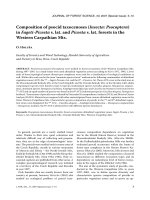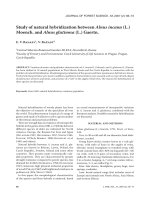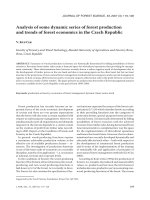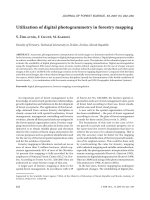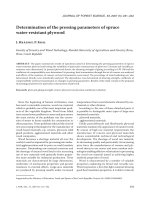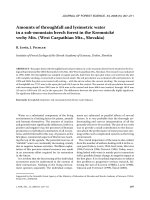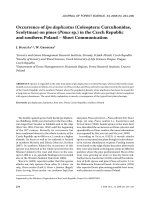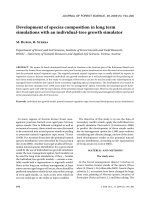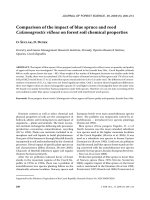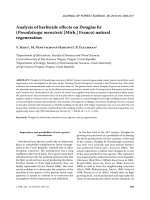Báo cáo lâm nghiệp: "Phenology of four broad-leaved forest trees in a submountain beech forest" pptx
Bạn đang xem bản rút gọn của tài liệu. Xem và tải ngay bản đầy đủ của tài liệu tại đây (238.95 KB, 8 trang )
J. FOR. SCI., 55, 2009 (1): 15–22 15
JOURNAL OF FOREST SCIENCE, 55, 2009 (1): 15–22
Four autochthonous broad-leaved tree species
(European beech, oak, hornbeam and lime-tree)
take up approximately 50% of the forest stand area
of the Slovakia (C 1998). Excepting horn-
beam, these tree species belong to woody plants
subjected to phenological monitoring in the frame-
work of the International Phenological Gardens
Program (C 1996). e climatological
monitoring, which is coordinated by the Slovak Hy-
drometeorological Institute (SHMI), also includes
phenological observations of the above forest trees
in Slovakia (B 2000). Phenology, usually
defined as the study of the seasonal timing of life
cycle events, is a suitable tool enabling us to study
the response of living organisms to the changes in
the environment connected with the current global
change (B et al. 2000; S et al. 2001; C-
et al. 2007). It is known that the beginning and
the course of phenological events are not the same
among the years. is variability is primarily con-
nected, in addition to biological characteristics, with
the seasonal variability of the climate characteristics
(M et al. 2001). In the ecosystems of decidu-
ous forests in the temperate zone, mainly the factors
such as temperature, moisture as well as photoperiod
influence the intensity of life events in plants (G et
al. 1998; A et al. 2000; K 2003). Nega-
tive effects of the climate change on trees have been
expected. Increased probability of late frost damage
because of the earlier onset of leaf emergence could
be caused by increased temperature sums during
the spring period (K 1995; D et al.
2005). Water deficit during the growing season could
also cause the weakening of competitive ability of
Supported by the Slovak Research and Development Agency under Contract No. APVV-0102-06 and by the Scientific Grant
Agency (VEGA) of the Ministry of Education of the Slovak Republic and the Slovak Academy of Sciences (Projects No. 2/7161/27,
2/7185/27 and 2/0045/08).
Phenology of four broad-leaved forest trees
in a submountain beech forest
B. S
1
, R. J
1
, Z. S
2
1
Institute of Forest Ecology, Slovak Academy of Sciences, Zvolen, Slovakia
2
Slovak Hydrometeorological Institute, Regional Centre, Banská Bystrica, Slovakia
ABSTRACT: e phenology of four deciduous forest tree species (Carpinus betulus L., Fagus sylvatica L., Quercus
dalechampii Ten., Tilia cordata Mill.) was studied in a submountain beech forest stand in Central Slovakia. Two spring
phenological phases – bud-burst and leaf unfolding as well as one autumn phase – autumn leaf colouring were moni-
tored over the period of 13 years. e results documented interannual variability in the dating of phenological phases
within the species, while the differences among the species were also revealed. Significant correlations (P < 0.05) were
detected between the dating of leaf unfolding and air temperature; the coefficients of correlation (r) ranged from –0.86
(hornbeam and beech) to –0.92 (oak). Significant relationships were also revealed between cumulative precipitation
amounts and timing of autumn leaf colouring phase (r-value ranged from –0.73 in oak to –0.81 in hornbeam). e
trend analysis showed that the onset of phenological phases was slightly shifted to the earlier dates during the period
of 13 years. However, the trends were not statistically significant.
Keywords: submountain beech forest; phenology; vegetative phenological phases; air temperature; precipitation
16 J. FOR. SCI., 55, 2009 (1): 15–22
some tree species, e.g. beech (G et al. 2007).
On the other hand, we can expect a relatively posi-
tive effect – longer duration of the growing season
(C, R 2001). But it is not clear
how these changes can affect the behaviour of trees
when their regulatory mechanisms are disrupted.
e aim of the present study is to analyze variabil-
ity in the onset of selected vegetative phenological
phases in four deciduous forest tree species in a
submountain beech forest stand during the period
of 13 years. Potential relationships between selected
climatic factors and phenological phases were also
studied.
MATERIAL AND METHODS
Study site
Investigations were carried out in a submoun-
tain beech forest stand at the Beech Ecological
Experimental Station (BEES), which is localized in
the south-east part of the Kremnické vrchy Mts.
(48°38'N, 19
o
04'E, 450–520 m a.s.l.). e study area
is situated on a slope 5–15° oriented to the west-
southwest. e soil cover is skeletal Cambisol with
moderate acid reaction and skeleton content rang-
ing from 10 to 60% (K et al. 1998). European
beech (Fagus sylvatica L.) at about 100 years of age
is a dominant woody species (85%). Fir (8%), oak
(4%), hornbeam (2%), and lime-tree (1%) are associ-
ated species. e vegetation cover mostly consists
of patches of Carici pilosae-Fagetum Oberd. 1957
and Dentario bulbiferae-Fagetum (Zlatník 1935)
Hartmann 1953 associations. Herbal species, such as
Carex pilosa Scop., Carex digitata L., Carex sylvatica
Huds., Dentaria bulbifera L., Galium odoratum
Scop., Athyrium filix-femina L. (Roth), Dryopteris
filix-mas (L.) Schott, represent the permanent ele-
ments of the associations (K et al. 1993). e
investigated area belongs to the moderately warm
region and moderately warm and humid hilly land
subregion (according to L et al. 2002). e mean
annual air temperature and mean annual rainfall
totals are 6.8°C and 780 mm, respectively. On aver-
age, the coldest month is January (–4°C), while the
warmest one is July (17°C). About 55% of the annual
precipitation amount falls from April to September
(S 1992). More information detailing the
BEES was described in papers published by K
(1993), B (2004), K et al. (2005), K-
and J (2006).
Phenological monitoring and meteo-data
Phenological observations were done according to
slightly modified methodology used by the Slovak
Hydrometeorological Institute (Slovenský hydro-
meteorologický ústav – SHMI 1996). Monitor-
ing (for the period 1995–2007) usually started on
March 1 and was repeated twice or three times a
week during the spring season. Autumn phenologi-
cal monitoring was carried out once a week. A set
of 10 sample adult trees with good health condition
was observed within each of the four species studied
(hornbeam – Carpinus betulus L., European beech
– Fagus sylvatica L., oak – Quercus dalechampii
Ten., lime tree – Tilia cordata Mill.). e Julian day
when the phase was observed on 50% of the studied
trees was taken as the beginning of the phenologi-
cal phase. e following phenological phases were
-1.0
-0.5
0.0
0.5
1.0
1.5
2.0
J F M A M J J A S O N D
Months
(°C)
A
-2.0
-1.0
0.0
1.0
2.0
3.0
1995
1997
1999
2001
2003
2005
2007
Years
(°C)
B
Fig. 1. Absolute (solid line) and standard-
ized (dashed line) differences between
mean monthly air temperatures (1995 to
2007) and long-term mean (1951–1980)
(A) and linear trend of temperature de-
viations averaged for the period March–
April (B) in Sliač (Central Slovakia)
–
–
–
–
J. FOR. SCI., 55, 2009 (1): 15–22 17
evaluated: 10% bud-burst (BB), 10% leaf unfolding
(LU) and 10% autumn colouring (AC).
Meteorological data (monthly air temperature
means and monthly precipitation amounts) for
the period of 13 years (1995–2007) were obtained
from the meteorological station in Sliač (monitored
by SHMI), which is situated at a direct distance of
4 km from the study area. Both absolute () and
standardized (/standard deviation) differences
between mean monthly air temperatures (averaged
for the period 1995–2007) and long-term mean
(1951–1980) reached the positive values from Janu-
ary to November, an evident increase was detected
for the period of April–August (Fig. 1A). e values
of the air temperature deviations, averaged for the
period of March–April, were increased during the
decade (Fig. 1B). e trend of the rainfall totals
averaged for the period of May–August adverts to
a slight decrease between 1995 and 2007 (Fig. 2).
Having regard to the phenological development of
40
60
80
100
120
140
1995 1997 1999 2001 2003 2005 2007
Years
(%)
Fig. 2. e trend of cumulative rainfall to-
tals for the period May–August between
1995–2007 (long-term mean
(1951–1980)
is
100%)
Table 1. e onset of phenological phases (Julian days) in four forest tree species studied between 1995 and 2007
Phenological phases
Bud-burst Leaf unfolding Autumn colouring
Tree species*
F.s. C.b. T.c. Q.d. F.s. C.b. T.c. Q.d. F.s. C.b. T.c. Q.d.
Minimum
101 90 106 108 110 106 110 112 254 251 245 255
Maximum 120 111 120 120 124 126 130 131 273 279 270 280
Mean 111 103 114 115 117 117 122 123 265 264 261 268
Variance range 19 21 14 12 14 20 20 19 19 28 25 25
St. deviation (±) 4.7 5.9 4.4 3.6 4.0 5.0 5.0 5.0 6.1 8.0 7.2 6.5
CV (%)
4.2 5.8 3.9 3.2 3.4 4.2 4.1 4.1 2.3 3.0 2.7 2.4
*F.s. – Fagus sylvatica, C.b. – Carpinus betulus, T.c – Tilia cordata, Q.d. – Quercus dalechampii, CV (%) – coefficient of
variation
Table 2. e duration of interphase intervals (in days) in the tree species studied between 1995 and 2007
Interphase intervals
Bud-burst – Leaf unfolding Leaf unfolding – Autumn colouring
Tree species* F.s. C.b. T.c. Q.d. F.s. C.b. T.c. Q.d.
Minimum 4 9 4 4 133 134 120 129
Maximum 9 24 12 12 163 166 154 164
Mean 6 15 8 9 148 147 139 145
Variance range 5 15 8 8 30 32 34 35
St. deviation (±) 1.7 3.9 2.5 2.7 7.7 8.5 8.4 8.7
CV (%) 27.3 26.9 31.6 31.2 5.2 5.8 6.0 6.0
*F.s. – Fagus sylvatica, C.b. – Carpinus betulus, T.c. – Tilia cordata, Q.d. – Quercus dalechampii, CV (%) – coefficient of
variation
18 J. FOR. SCI., 55, 2009 (1): 15–22
studied trees, temperature sums, used in the cor-
relation analysis, were calculated as the sums of cu-
mulated positive average monthly air temperatures
(CPAMAT) over the period from March to April
(according to B, B 1996; S-
2006a). e rainfall totals were calculated for the
period of May–August (according to K,
B 1999). e degree of correlation of two
variables – onset of phenological phase (expressed
as a Julian day) versus temperature or precipitation,
respectively, was couched in a coefficient of linear
correlation (Pearson’s product moment).
RESULTS
During the period of phenological monitoring
(1995–2007), interannual variability in the onset
of two spring phenological phases as well as one
autumn phenological phase within the species was
determined (Table 1). Among the species, the ear-
liest onset of bud-burst on average was observed
in hornbeam (103
rd
day), the latest one was in oak
(115
th
day). e variability (standard deviation) in the
onset of this phase within the species ranged from
3.6 days (oak) to 5.9 days (hornbeam). As for the
leaf unfolding phase, the earliest onset on average
was observed in beech and hornbeam (117
th
day),
while the latest occurrence was in oak (123
rd
day).
e variability in the onset of leaf unfolding ranged
from 4.0 days (beech) to 5.0 days (other species). e
earliest occurrence of autumn colouring, averaged
for the period of 13 years, was determined in lime-
tree (261
st
day), while the latest one was observed
in oak (268
th
day). e variability in the dating of
this phase ranged from 6.1 days (beech) to 8.0 days
(hornbeam).
e dynamics of the assimilatory apparatus de-
velopment is presented by means of the interphase
interval bud-burst-leaf unfolding (BB-LU) duration.
It is clear that the lowest dynamics was observed
in hornbeam, while the leaf development in beech
was more rapid (Table 2). e shortest duration, on
average, was observed in beech (6 days), the longest
duration was in hornbeam (15 days). Interannual
variability in the duration of the interval BB-LU
within the species ranged from 1.7 days (beech)
to 3.9 days (hornbeam). On the other hand, the
shortest interphase interval leaf unfolding-autumn
colouring, which represents the vegetation period of
trees, was observed in lime-tree. Longer vegetation
period, detected in other species, reached nearly
equal values. e length of the interphase interval
from leaf unfolding to autumn colouring (LU-AC)
ranged from 139 days (lime-tree) to 148 days (beech).
e variability in the duration of LU-AC within the
trees reached the limit values from 7.7 days (beech)
to 8.7 days (oak).
e correlation analysis between air temperature
and onset of leaf unfolding confirmed a statistically
significant correlation (P < 0.05) in all species studied
between 1995 and 2007 (Fig. 3). e coefficients of
correlation reached the following values: beech and
hornbeam (r = –0.86), lime-tree (r = –0.89) and oak
(r = –0.92). e correlation between the beginning
of autumn leaf colouring and rainfall totals calcu-
lated for the period of May–August also revealed
Fagus sylvatica L.
R
2
= 0.7323
100
110
120
130
140
8 10 12 14 16 18
Temperature (°C)
Julian days
Carpinus betulus L.
R
2
= 0.7432
100
110
120
130
140
8 10 12 14 16 18
Temperature (°C)
Julian days
Tilia cordata Mill.
R
2
= 0.8023
100
110
120
130
140
8 10 12 14 16 18
Temperature (°C)
Julian days
Quercus dalechampii Ten.
R
2
= 0.8423
100
110
120
130
140
8 10 12 14 16 18
Temperature (°C)
Julian days
Fig. 3. e relationships between dating of leaf unfolding and temperature (CPAMAT) calculated for the period of March–April
during 1995–2007
J. FOR. SCI., 55, 2009 (1): 15–22 19
a significant correlation. e values of correlation
coefficients ranged from r = –0.73 (oak) to r = –0.81
(hornbeam, Fig. 4). e interannual course in the
onset of leaf unfolding as well as autumnal leaf
colouring for the species studied between 1995 and
2007 is illustrated in Figs. 5 and 6. Linear trends
showed that the onset of both phenological phases
was slightly shifted to the earlier dates during the
period of 13 years. However, the trends were not
statistically significant (P < 0.05).
DISCUSSION
e data in Table 1 show differences in the dating
of phenological phases among the species studied
between 1995 and 2007. On average, the earliest on-
set of both spring phases was observed in hornbeam.
Especially in the case of bud-burst the leading of horn-
beam is evident. We suppose that this fact is related
to its biological characteristics, e.g. lower sensitivity to
the day-length compared to beech (H 1993). On
the other hand, the latest onset of both spring phases
was observed in oak, which is more exacting on tem-
perature conditions compared to the other species. On
average, the earliest autumn colouring was observed
in lime-tree, the latest one was detected in oak. It is
possible that the reason for this pattern is the higher
sensitivity of lime-tree to drought compared to oak.
Interannual differences in the onset of pheno-
logical phases within the species are influenced by a
Fagus sylvatica L.
R
2
= 0.5811
240
250
260
270
280
290
100 200 300 400 500
Precipitation (mm)
Julian days
Carpinus betulus L.
R
2
= 0.6565
240
250
260
270
280
290
100 200 300 400 500
Precipitation (mm)
Julian days
Tilia cordata Mill.
R
2
= 0.6419
240
250
260
270
280
290
100 200 300 400 500
Precipitation (mm)
Julian days
Quercus dalechampii Ten.
R
2
= 0.534
240
250
260
270
280
290
100 200 300 400 500
Precipitation (mm)
Julian days
Fig. 4. e relationships between dating of autumn leaf colouring and cumulative rainfall amounts calculated for the period of
May–August during 1995–2007
Fig. 5. e onset of leaf unfolding in the species studied between 1995–2007. A linear trend is evident
Fagus sylvatica L.
100
110
120
130
140
1995
1997
1999
2001
2003
2005
2007
Years
Julian days
Carpinus betulus L.
100
110
120
130
140
1995
1997
1999
2001
2003
2005
2007
Years
Julian days
Tilia cordata Mill.
100
110
120
130
140
1995
1997
1999
2001
2003
2005
2007
Years
Julian days
Quercus dalechampii Ten.
100
110
120
130
140
1995
1997
1999
2001
2003
2005
2007
Years
Julian days
Julian days
Julian days
Julian days
20 J. FOR. SCI., 55, 2009 (1): 15–22
range of factors (H, H 1988; S
2006b). Temperature and moisture are considered to
be the most important ecological factors influencing
the intensity of life manifestations (V W
et al. 1995; W 1999). erefore, using the
correlation analysis, we examined the relationships
between the dating of the onset of phenological
phases and meteorological factors (temperature,
rainfall amounts) in the foregoing period. e analy-
sis revealed the correlation between the beginning
of leaf unfolding phase in the studied species and air
temperature, namely the CPAMAT summary value.
e sum of CPAMAT over the periods of March–
April correlates significantly with the beginning of
this phenophase in all species. In the years with
the highest summary value of temperatures (1999,
2000 and 2007) we observed the earliest beginning
of this phenological phase. Contrariwise, the lower
temperature sums of CPAMAT (1996 and 1997)
were related to later onset. e trend of the dating
of leaf unfolding over the period 1995–2007 showed
a shift to the earlier dates. We suppose that there is
a possible relation between the earlier onset of this
phenological phase and climate warming in the last
decade (see Fig. 1B). A similar trend was observed by
other authors (M et al. 1989; C,
R 2001; M et al. 2001; S 2005;
B, M 2007). e phenological
phase of autumn leaf colouring signalizes the ending
of the vegetation period. A decrease in chlorophyll
contents in the assimilatory apparatus is evident,
thereby there is a change in the colour of leaf blade.
Excluding the biological characteristics of the spe-
cies, extreme dating of the beginning of autumn leaf
colouring reflects the interannual variability with
extremities (above-average or below-average charac-
teristics) of the climatic variables (e.g. drought or low
air temperatures). Our correlation analysis showed
that there is a significant relationship between rain-
fall amounts in the period of May–August and dating
of this autumn phase. In all species, the earliest onset
was observed in 1998, the latest one was detected
in 1999. In 1998, there was an evident deficit of soil
moisture at the beginning of autumn (70% amount
of the long-term normal) with a clear decrease in the
minimal air temperature. On the other hand, there
were favourable ecological conditions (sufficient soil
moisture and temperature regime) during the same
period in 1999. ese findings correspond to those
published by K and B (1999). It
is interesting that both extremes were found in two
successive years. It could be connected with natural
variability in the seasonal course of climate charac-
teristics, having together with the biological factors
a dominant effect on the course of life activities (e.g.
phenological phases) in woody plant species.
CONCLUSION
e phenology of four deciduous forest tree spe-
cies (Carpinus betulus L., Fagus sylvatica L., Quercus
dalechampii Ten., Tilia cordata Mill.) was studied in
a submountain beech forest stand, which is localized
in the Kremnické vrchy Mts. (Western Carpathians,
Central Slovakia). Two spring phenological phases
– 10% bud-burst and 10% leaf unfolding as well as
Fagus sylvatica L.
240
250
260
270
280
290
1995
1997
1999
2001
2003
2005
2007
Years
Julian days
Carpinus betulus L.
240
250
260
270
280
290
1995
1997
1999
2001
2003
2005
2007
Years
Julian days
Tilia cordata Mill.
240
250
260
270
280
290
1995
1997
1999
2001
2003
2005
2007
Years
Julian days
Quercus dalechampii Ten.
240
250
260
270
280
290
1995
1997
1999
2001
2003
2005
2007
Years
Julian days
Fig. 6. e onset of autumn leaf colouring in the species studied between 1995–2007. A linear trend is depicted
J. FOR. SCI., 55, 2009 (1): 15–22 21
one autumn phase – 10% autumn leaf colouring
were monitored from 1995 to 2007. The results
documented interannual variability in the dating of
phenological phases within the species, while the dif-
ferences among the species were also revealed. e
reasons for the variability are not only biological (ge-
netic, physiologic) characteristics of the species but
also the climatic factors play an important role in the
dynamics of phenological development. ere were
significant relationships between the onset of leafing
and the sum of air temperatures during the spring
period (March–April). Similarly, the beginning of
autumn colouring was significantly correlated with
rainfall amounts during the period from May to
August. e beginning of phenological phases was
slightly shifted to the earlier dates between 1995
and 2007. However, the trends were not statistically
significant (P < 0.05).
R ef er en ces
AHAS R., JAAGUS J., AASA A., 2000. e phenological calen-
dar of Estonia and its correlation with mean air temperature.
International Journal of Biometeorology, 44: 159–166.
BARNA M., 2004. Adaptation of European beech (Fagus
sylvatica L.) to different ecological conditions: leaf size
variation. Polish Journal of Ecology, 52: 35–45.
BEDNÁŘOVÁ E., MERKLOVÁ L., 2007. Results of monitor-
ing the vegetative phenological phases of European beech
(Fagus sylvatica L.) in 1991–2006. Folia Oecologica, 34:
77–85.
BOLLIGER J., KIENAST F., ZIMMERMANN N.E., 2000. Risk
of global warming on montane and subalpine forests in
Switzerland – a modelling study. Regional Environmental
Change, 1: 99–111.
BRASLAVSKÁ O., 2000. Monitoring zmeny klímy v rastlin-
ných ekosystémoch prostredníctvom fenologických pozo-
rovaní. Životné prostredie, 34: 81–83.
BRASLAVSKÁ O., BORSÁNYI P., 1996. Quality control of
long series of phenological data with sum of cumulated av-
erage monthly air temperatures. In: DALEZIOS N.R. (ed.),
International Symposium on Applied Agrometeorology and
Agroclimatology. Proceedings Volos, Greece: 305–310.
CLELAND E., CHUINE I., MENZEL A., MOONEY H.A.,
SCHWARTZ M.D., 2007. Shifting plant phenology in re-
sponse to global change. Trends in Ecology and Evolution,
22: 357–365.
COLLECTIVE, 1998. Green Report. Bratislava, Ministry of
Agriculture, Food, Forestry and Water Management of the
Slovak Republic: 169.
DITTMAR CH., FRICKE W., ELLING W., 2005. Impact of
late frost events on radial growth of common beech (Fagus
sylvatica L.) in Southern Germany. European Journal of
Forest Research, 125: 249–259.
GESSLER A., KEITEL C., KREUZWIESER J., MATYSSEK
R., SEILER W., RENNENBERG H., 2007. Potential risk for
European beech (Fagus sylvatica L.) in a changing climate.
Trees, 21: 1–11.
GILL D.S., AMTHOR J.S., BORMANN F.H., 1998. Leaf
phenology, photosynthesis and persistence of saplings and
shrubs in a mature northern hardwood forest. Tree Physiol-
ogy, 18: 281–289.
HÄKKINEN R., HARI P., 1988. e efficiency of time and
temperature driven regulation principles in plants at the be-
ginning of the active period. Silva Fennica, 22: 163–170.
HEIDE O.M., 1993. Daylength and thermal time responses
of budburst during dormancy release in some northern
deciduous trees. Physiologia Plantarum, 88: 531–540.
CHMIELEWSKI F.M., 1996. e International Phenological
Gardens across Europe. Present state and perspectives.
Phenology and Seasonality, 1: 19–23.
CHMIELEWSKI F.M., RÖTZER T., 2001. Response of tree
phenology to climate change across Europe. Agricultural
and Forest Meteorology, 108: 101–112.
KAMENSKÝ L., BRASLAVSKÁ O., 1999. Fenologické
charakteristiky listnatých drevín na Slovensku v období
1986–1995. Meteorologický časopis – Meteorological
Journal, 2: 49–55.
KELLEROVÁ D., JANÍK R., 2006. Air temperature and
ground level ozone concentration in submountain beech
forest (Western Carpathians, Slovakia). Polish Journal of
Ecology, 54: 505–509.
KIKUZAWA K., 2003. Phenological and morphological
adaptations to the light environment in two woody and
two herbaceous plant species. Functional Ecology, 17:
29–38.
KODRÍK M., 1993. Tree layer below-ground biomass of fir-
beech forest in the Middle Slovakia. Ekológia (Bratislava),
16: 17–22.
KONTRIŠ J., KONTRIŠOVÁ O., GREGOR J., 1993. Dynam-
ics of the phytocoenoses development of the submountain
beech forest stands. I. Phytocoenoses. Ekológia (Bratislava),
12: 417–428.
KRAMER K., 1995. Phenotypic plasticity of the phenology of
seven European tree species in relation to climatic warming.
Plant, Cell and Environment, 18: 93–104.
KUKLA J., KONTRIŠ J., KONTRIŠOVÁ O., GREGOR J.,
MIHÁLIK A., 1998. Causes of floristical differentiation
of Dentario bulbiferae-Fagetum (Zlatník 1935) Hartmann
1953 and Carici pilosae-Fagetum Oberd. 1957 associations.
Ekológia (Bratislava), 17: 177–186.
KUKLOVÁ M., KUKLA J., SCHIEBER B., 2005. Individual and
population parameters of Carex pilosa Scop. (Cyperaceae)
in four forest sites in Western Carpathians (Slovakia). Polish
Journal of Ecology, 53: 427–434.
LAPIN M., FAŠKO P., MELO M., ŠŤASTNÝ P., TOMLAIN J.,
2002. Klimatické oblasti. In: MIKLOS L. (ed.), Atlas krajiny
Slovenskej republiky. Bratislava, MŽP: 344.
22 J. FOR. SCI., 55, 2009 (1): 15–22
MENZEL A., ESTRELLA N., FABIAN P., 2001. Spatial and
temporal variability of the phenological seasons in Germany
from 1951 to 1996. Global Change Biology, 7: 657–666.
MURRAY M.B., CANNEL M.G.R., SMITH R.I., 1989. Date of
budburst of fifteen tree species in Britain following climate
warming. Journal of Applied Ecology, 26: 693–700.
SAXE H., CANNEL M.G.R., JOHNSEN Ø., RYAN M., VOUR-
LITIS G., 2001. Tree and forest functioning in response to
global warming. New Phytologist, 149: 369–400.
SCHIEBER B., 2005. Onset and course of selected phenologi-
cal phases in European beech (Fagus sylvatica L.) over the
last 10 years. Meteorologický časopis – Meteorological
Journal, 8: 9–12.
SCHIEBER B., 2006a. Phenology of leafing and yellowing of
leaves in selected forest trees in Slovakia. Nauka za Gorata
– Forest Science, 43: 29–36.
SCHIEBER B., 2006b. Spring phenology of European beech
(Fagus sylvatica L.) in submountain beech forest stand with
various stocking between 1995–2004. Journal of Forest
Science, 52: 208–216.
SLOVENSKÝ HYDROMETEOROLOGICKÝ ÚSTAV, 1996.
Fenologické pozorovanie lesných rastlín. Metodický pred-
pis. Bratislava: 22.
STŘELEC J., 1992. Vplyv ťažbového zásahu v bukovom poraste
na zmeny osvetlenia. Lesnícky časopis – Forestry Journal,
38: 551–558.
VON WUEHLISCH G., KRUSCHE D., MUHS J., 1995. Varia-
tion in temperature sum requirement for flushing of beech
provenances. Silvae Genetica, 44: 343–346.
WIELGOLASKI F.E., 1999. Starting dates and basic tempera-
tures in phenological observations of plants. International
Journal of Biometeorology, 42: 158–168.
Received for publication June 4, 2008
Accepted after corrections September 15, 2008
Corresponding author:
Mgr. B S, Ph.D., Ústav ekológie lesa SAV, Štúrova 2, 960 53 Zvolen, Slovensko
tel.: + 421 455 330 914, fax: + 421 455 479 485, e-mail:
Fenológia štyroch druhov listnatých drevín v submontánnej bučine
ABSTRAKT: Študovali sme fenológiu štyroch opadavých lesných drevín (Carpinus betulus L., Fagus sylvatica
L., Quercus dalechampii Ten., Tilia cordata Mill.) v podmienkach submontánnej bučiny na strednom Slovensku.
V priebehu 13 rokov boli monitorované dve jarné vegetatívne fenofázy – rozpuknutie pupeňa a zalisťovanie – a jedna
jesenná vegetatívna fenofáza – jesenné prefarbovanie listov. Výsledky poukazujú na medziročnú variabilitu v nástupe
fenologických fáz v rámci druhov ako aj na rozdiely medzi druhmi. Zistili sa štatisticky významné (
P < 0,05) vzťahy
medzi nástupom zalisťovania a teplotou vzduchu; hodnoty koeficientov korelácie (
r) sa pohybovali od –0,86 (hrab,
buk) do –0,92 (dub). Takisto aj medzi nástupom jesenného prefarbovania listov a zrážkami boli zistené významné
vzťahy (hodnota r sa pohybovala od –0,73 u duba do –0,81 u hraba). Trendová analýza nástupu fenofáz za obdobie
13 rokov poukazuje na ich mierny posun ku skorším termínom, avšak trendy nie sú štatisticky významné.
Kľúčové slová: submontánna bučina; fenológia; vegetatívne fenofázy; teplota vzduchu; zrážky
